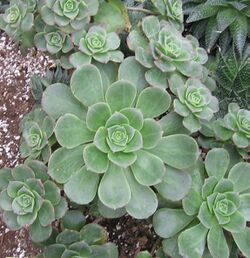Biology:Aeonium haworthii
| Aeonium haworthii | |
|---|---|

| |
| Scientific classification | |
| Kingdom: | Plantae |
| Clade: | Tracheophytes |
| Clade: | Angiosperms |
| Clade: | Eudicots |
| Order: | Saxifragales |
| Family: | Crassulaceae |
| Genus: | Aeonium |
| Species: | A. haworthii
|
| Binomial name | |
| Aeonium haworthii Webb & Berthel.
| |
| Synonyms[1] | |
| |
Aeonium haworthii, also known as Haworth's aeonium or pinwheel, is a species of succulent flowering plant in the family Crassulaceae. It is grown as a houseplant in temperate regions. It has gained the Royal Horticultural Society's Award of Garden Merit,[2] as has the cultivar 'Variegatum'.[3]
Distribution
A. haworthii is native to the Canary Islands and northern Africa, but it has been introduced to other areas of similar climate, such as Southern California.[4] In the United States , it is suitable to be grown outside in USDA hardiness zones 9-11.[5] This species is drought tolerant and prefers full sun.[6] It is sometimes susceptible to aphids and mealybugs.[7] It is a sand-dwelling beach plant, a subshrub with rough, woody stems and rosettes of thick, red-edged green leaves which are triangular or diamond- or spade-shaped.[4]
Description
It grows as a densely branched small shrub and reaches stature heights of up to 60 centimeters. The almost bare, somewhat mesh-like, ascending or hanging, winding shoots have a diameter of 3 to 6 millimeters. Their rather flat rosettes reach a diameter of 6 to 11 centimeters. The inner leaves are more or less upright. The obovate, green or yellowish green, often very heavily bluish, almost bare leaves are 3 to 5.5 centimeters long, 1.5 to 3 centimeters wide and 0.25 to 0.4 centimeters thick. They are pointed and trimmed towards the top. The base is wedge-shaped. The leaf margin is covered with curved eyelashes that are 0.4 to 0.8 millimeters long. The leaves are often reddish variegated along the edge.[8]
It has panicles of cream-colored pointed flowers produced in spring.[5] The loose, hemispherical inflorescence has a length of 6 to 16 centimeters and a width of 6 to 16 centimeters. The peduncle is 1 to 9 centimeters long. The seven-to nine-digit flowers are on a 2 to 12 millimeter long, bare flower stem. Its sepals are bald. The pale yellow to whitish, pink variegated, lanceolate, pointed petals are 7 to 9 millimeters long and 1.2 to 1.8 millimeters wide. The stamens are almost glabrous to sparsely weak downy.[9]
Cultivars
References
- ↑ The Plant List: A Working List of All Plant Species, http://www.theplantlist.org/tpl1.1/record/kew-2623586, retrieved 30 July 2016
- ↑ "RHS Plant Selector - Aeonium haworthii". https://www.rhs.org.uk/Plants/504/Aeonium-haworthii/Details. Retrieved 23 February 2020.
- ↑ 3.0 3.1 "Aeonium haworthii 'Variegatum'". Royal Horticultural Society. https://www.rhs.org.uk/Plants/83865/i-Aeonium-haworthii-i-Variegatum-(v)/Details. Retrieved 3 January 2018.
- ↑ 4.0 4.1 4.2 "Aeonium haworthii 'Kiwi'" (in en). https://www.gardenersworld.com/plants/aeonium-haworthii-kiwi/.
- ↑ 5.0 5.1 "Aeonium Haworthii Care: Growing Pinwheel Plants" (in en-US). 2019-06-01. https://plantcaretoday.com/aeonium-haworthii.html.
- ↑ 6.0 6.1 "Kernock Park Plants Ltd Aeonium haworthii 'Bicolor'". https://www.kernock.co.uk/acatalog/info_U6344.html.
- ↑ Ltd, GardensOnline Pty. "Aeonium haworthii | GardensOnline". https://www.gardensonline.com.au/gardenshed/plantfinder/show_3694.aspx.
- ↑ Reto Nyffeler: Aeonium haworthii . In: Urs Eggli (ed.): Succulent plant dictionary. Crassulaceae (thick leaf family) . Eugen Ulmer, Stuttgart 2003, ISBN:3-8001-3998-7 , p. 17 .
- ↑ RHS A-Z encyclopedia of garden plants. United Kingdom: Dorling Kindersley. 2008. pp. 1136. ISBN 1405332964.
External links
| Wikimedia Commons has media related to Aeonium haworthii. |
Wikidata ☰ Q511569 entry
 |


